Domestic pets and wildlife
Domestic cats and dogs pose a serious threat to wildlife because of their natural hunting instincts. With a large numbers of unowned (stray and feral) and free-roaming cats and dogs in Australia, it’s important to manage domestic pets to minimise the damage that can be done to other, more vulnerable species.
According to the RSPCA, there are around 4.2 million pet dogs in Australia; 19 dogs for every 100 people. There are estimated to be 3.3 million pet cats in Australia; 15 cats for every 100 people. [1]
In regard to cats, it’s difficult to estimate the impact on wildlife of those kept as domestic pets. Studies suggest that a suburban domestic cat can bring home anywhere from 5 to 30 vertebrates a year (including native and introduced species) [2]. However, a study from 2009 concluded that although domestic and stray cats had contributed to declines of suburban populations of Eastern barred bandicoots and superb Lyrebirds, the overall effects of cats on prey communities remain speculative [3].
Domestic cats take a broad range of prey, with small mammals, birds, and human-derived foods forming the bulk of their diet [4]. They can sometimes also benefit natural ecosystems by reducing damage by introduced rats and other predators of birds for instance [5].
Unowned cats also feed on wildlife although a recent study suggests that the population may be much lower than the often-quoted figure of 12-20 million, likely to be 2.1 million to 6.3 million depending on prey availability and climate [6]. There are currently government programs designed to reduce the number of unowned cats.
Every cat and dog deserves a safe home where it is loved, cared for and kept free from hazards. It is also possible to help your pets and wildlife co-exist safely by following the steps below:
• Keep your cat inside, at least at night when native animals are most active - read the Cat Protection Society factsheet on how to make your pet a happy and healthy indoor cat
• If possible keep dogs inside at night or confined to a secure space when native animals are most active
• Provide sufficient food and shelter for your pets
• Provide a safe environment for wildlife in your garden by having separate areas for pets e.g. a fully enclosed cat run - read the Cat Protection Sociey factsheet on cat enclosures
• Identify your pet with a collar, tag and microchip and add collar bells for cats
• De-sex your pets to prevent unwanted litters
A cat run or pet enclosure will give your cat the best of both worlds – the safety of life inside, with access to a secure outdoor area. It can be constructed around a tall tree, allowing your cat the freedom to climb, scratch and perch in a high place.
Never feed a stray cat or dog unless you intend to care for it as a pet. If you notice feral animals or strays in the area, call your local Council or the Cat Protection Society.
If you find a sick, injured or orphaned native animal in your house or yard, please keep all pets and people away to minimise stress to the animal and increase its chance of survival and read our rescue advice for more information.
If there is the chance one of your pets has held a native animal in their mouth, even if the native animal looks unharmed, please take it to a vet for assessment, or call WIRES 1300 094 737 for rescue assistance, as native animals need to be given antibiotics after they have had contact with the saliva of dogs and cats. If you let WIRES know the vet you’ve taken the animal to, we will follow up directly with the vet to bring the animal into care as soon as it’s received vet treatment.
Helpful contact numbers
Catnip Modular Cat Parks 1800 639 998
Cats Inside Out Cat Enclosures 0408 060 164
Cat Protection Society (02) 9519 7201
RSPCA (02) 9770 7555
Newsletter
Stay in touch with our regular rescue stories and WIRES updates.

